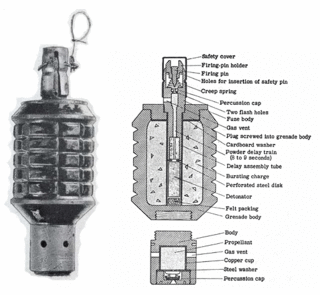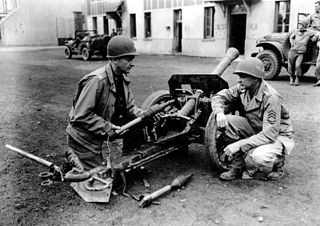
A grenade launcher is a weapon that fires a specially designed, large-caliber projectile, often with an explosive, smoke, or gas warhead. Today, the term generally refers to a class of dedicated firearms firing unitary grenade cartridges. The most common type are man-portable, shoulder-fired weapons issued to individuals, although larger crew-served launchers are issued at higher levels of organization by military forces.

"Mills bomb" is the popular name for a series of British hand grenades which were designed by William Mills. They were the first modern fragmentation grenades used by the British Army and saw widespread use in the First and Second World Wars.

The M203 is a single-shot 40 mm under-barrel grenade launcher designed to attach to a rifle. It uses the same rounds as the older stand-alone M79 break-action grenade launcher, which utilizes the high-low propulsion system to keep recoil forces low. Quite versatile and compatible with many rifle models, the M203 was originally designed for the U.S. M16 and its carbine variant, the M4. The launcher can also be mounted onto a C7, a Canadian version of the M16 rifle; however, this requires the prior removal of the bottom handguard.
A rifle grenade is a grenade that uses a rifle-based launcher to permit a longer effective range than would be possible if the grenade were thrown by hand.

The FN F2000 is a 5.56×45mm NATO bullpup rifle, designed by FN Herstal in Belgium. The F2000 made its debut in March 2001 at the IDEX defence exhibition held in Abu Dhabi, in the United Arab Emirates.

The GP-25 Kostyor ("Bonfire"), GP-30 Obuvka ("Shoe") and GP-34 are a family of Russian 40 mm under-barrel muzzleloaded grenade launchers for the AK family of assault rifles. They were first seen by the West in 1984, during the Soviet Invasion of Afghanistan. The GP-30 was lightened and the redesigned sighting system was moved to the right.
The RK 95 TP, officially 7.62 RK 95 TP and commercially known as the M95, is a 7.62×39mm Finnish assault rifle adopted in relatively small numbers by the Finnish Defence Forces in the 1990s. The RK 95 TP originally featured many improvements including a fire control selector and a muzzle device that enabled the firing of rifle grenades, the attachment of a suppressor, or bayonet. The rifle is only used by Finland.

The Type 11 70 mm infantry mortar, was a muzzle-loading, rifled bore infantry mortar used by the Japanese. The Type 11 designation was given to this gun as it was accepted in the 11th year of Emperor Taishō's reign (1922). It was first used in 1922 and was the first mortar to be introduced by the Imperial Japanese Army. The Type 11 was later replaced by the Type 92 battalion gun.
The Type 10 grenade was the first fragmentation hand grenade designed and deployed by the Imperial Japanese Army.

The Panzerbüchse 39, abbreviated PzB 39, was a German anti-tank rifle used in World War II. It was an improvement of the Panzerbüchse 38 rifle.

The Type 91 hand grenade was an improved version of the Type 10 fragmentation hand grenade/rifle grenade of the Imperial Japanese Army. Although superseded as a hand-thrown weapon by the Type 97 by the start of World War II it was still used by units in the Second Sino-Japanese War and by reserve forces, as well as the Japanese Navy's Special Naval Landing Forces.
The Type 91 Grenade Launcher is a Chinese grenade launcher used to launch 35mm non-lethal grenades. It may come in shoulder-launched, rifle-attached, and vehicle-mounted variants. The rifle mounted version has a similar loading mechanism to the American made M203.

The HK69A1 is a 40 mm grenade launcher developed and produced by the German arms manufacturer Heckler & Koch (H&K). The weapon was designed to engage enemy troops and strongpoints out to a distance of 350 m; it can also be used to deploy smoke grenades and illumination flares.
The SG 550 is an assault rifle manufactured by SIG Sauer AG in Switzerland. "SG" is an abbreviation for Sturmgewehr. The rifle is based on the earlier 5.56×45mm NATO SIG SG 540.

The 8.8 cm Raketenwerfer 43 Puppchen was an 88 mm calibre reusable anti-tank rocket launcher developed by Nazi Germany during World War II.

A 22 mm rifle grenade is inserted over the firing mechanism on the front of rifles that are equipped with the appropriate spigot-type launcher, either in the form of an integral flash suppressor or a detachable adapter. As with most rifle grenades, it is propelled by a blank cartridge inserted into the chamber of the rifle. A 22 mm grenade can range from a powerful anti-tank round to a simple finned tube with a fragmentation hand grenade attached to the end. The "22 mm" refers to the diameter of the base tube which fits over the spigot of the launcher, not the diameter of the warhead section, which is much wider.

The M7 grenade launcher, formally rifle grenade launcher, M7, was a 22 mm rifle grenade launcher attachment for the M1 Garand rifle that saw widespread use throughout World War II and the Korean War. The M7 was a tube-shaped device, with one end slotting over the muzzle of the rifle and attaching to the bayonet mount, and the other end holding the grenade in place. Blank cartridges were loaded into the rifle prior to firing. When fired, the expanding gases generated by the cartridges propelled the grenade forward with considerable force. The M7 could fire grenades up to 200 metres, compared with the maximum of 30 metres achieved by a hand-thrown grenade.
The Hales rifle grenade is the name for several rifle grenades used by British forces during World War I. All of these are based on the No. 3 design.












